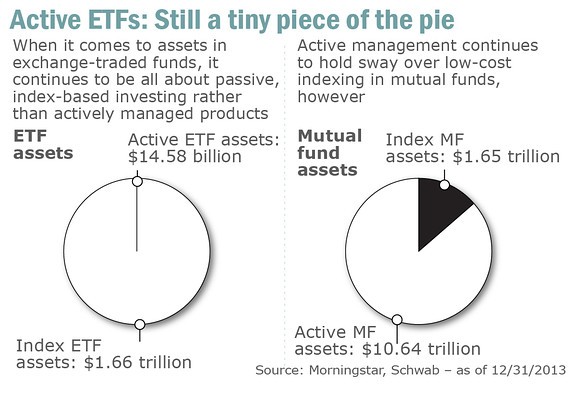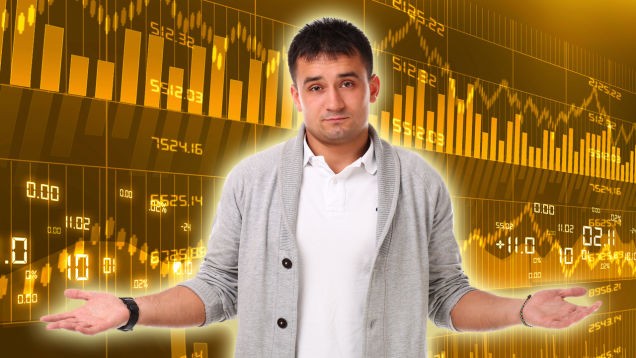Four Reasons to Invest in ETFs And Five Ways to Get Started
Post on: 1 Май, 2015 No Comment

display>
A mere 15 years ago, selecting the right exchange-traded fund (ETF) was no big challenge. That’s because the first ETF wasn’t introduced until 1993, and the second didn’t follow until 1995. Since then, however, the growth rate among these versatile investment vehicles has been exponential so fast, in fact, that the monitoring firm Morningstar now tracks the performance of 854 ETFs, with new funds being added almost weekly.
So, from this mushrooming roster of new ETFs now covering virtually every market sector, both domestic and international how do you select the right one (or, more likely, ones) for your portfolio?
If you’re not already familiar with ETFs. here are four reasons why you should consider adding some balance to your portfolio.
Reason #1: ETFs allow you to better focus your investments.
While many ETFs represent large portfolios of stocks or bonds, typically tracking major indexes, many others are more narrowly focused than traditional mutual funds. These instruments represent small market sectors, sets of foreign stocks, or even individual commodities that are hard to access via futures or individual stocks.
For example, lithium is generally considered a fuel of the future, since it has multiple uses in green energy systems and batteries for powering hybrid and electric cars. However, there are no lithium futures, meaning you can’t trade in the metal directly, and most of the lithium mining and production companies still have stocks mired in the high-risk penny class.
You can, however, make an easy play on lithium by buying shares of the Global X Lithium ETF (NYSE: LIT ), which invests in lithium mining stocks, shares of battery makers and stocks of the metal’s other end users.
Reason #2: ETFs give you access to markets or investment areas that might otherwise be restricted, too expensive, or highly risky to trade.
There are a limited number of traditional mutual funds and single-country funds targeting the secondary overseas markets or specific sectors within the larger foreign bourses. However, there are now roughly 300 international, regional, and foreign-country ETFs listed on U.S. exchanges that you can use to add a global perspective to your portfolio.
That means you can make a play on an entire major foreign market such as China with a fund like the iShares FTSE/Xinhua China 25 (NYSE: FXI ). FXI tracks China’s leading stock index, has $8.2 billion in assets and is up 5.6% since hitting yearly lows in mid-July.
You also can target a specific segment of China’s market, such as the top manufacturers, with an ETF like the Global X China Industrials(NYSE: CHII ). Started in December 2009, CHII mirrors China’s S-BOX Industrial Index, has a market capitalization of $26.6 million, and is up 19.9% from its early July lows.
You can move into smaller, high-performing foreign markets as well with ETFs like the iShares MSCI Thailand Index Fund (NYSE: THD ). Formed in March 2008, THD bottomed in December of that year amid the global financial turmoil, but has been on a tear ever since, returning 45.6% over the past year. THD’s market cap is now over $552 million.
If you can’t find an ETF for the country you want, just wait a bit new ones are coming online at a frantic pace. For example, the Market Vectors Vietnam Fund (NYSE: VNM ) just turned one-year-old last month and the Market Vectors Poland ETF (NYSE: PLND ) is barely nine months old.
There’s also a growing array of broader ETFs that track multiple foreign markets, both developed and emerging.
A top performer among the first group is the iShares MSCI EAFE Growth Index ETF (NYSE: EFG ). which tracks major stocks in the biggest markets in Europe, Asia, Australia and the Far East. With a market cap of $1.3 billion, it’s been weighed down somewhat by the recurring European debt crisis, but it’s still managed a 2.53% return over the past year.
A good example in the broad emerging-markets class is the Vanguard Emerging Markets ETF (NYSE: VWO ). One of the older and larger funds, VWO has a market cap of $27.8 billion and holds shares of more than 700 companies in 23 developing countries around the globe. Size hasn’t hurt its performance, however, as it has returned a healthy 14.81% over the past 52 weeks.
ETF designers are also moving beyond the world of equities and into the realm of hard assets from precious and industrial metals to currencies, real estate and even agricultural commodities, which until now have been off limits to many smaller investors because of high risks and margin requirements.
One of the first pure play agricultural ETFs is the Teucrium Corn Fund (NYSE: CORN ). which tracks the daily closing prices of the three nearest corn futures contracts on the Chicago Board of Trade (CBOT). Announced in April, it began trading in early June and has risen steadily ever since along with corn prices gaining 27.29% in three months.
Despite the trouble in the U.S. housing market, real estate ETFs have been hot over the past year, with the sector listed No. 1 in Morningstar’s 52-week performance review. In fact, the Direxion Daily Real Estate Bull 3X Fund (NYSE: DRN ) a highly leveraged ETF that tries to triple the performance of the MSCI REIT (real estate investment trust ) Index topped Morningstar ‘s most recent individual yearly return chart (up 78.3%).
If you want a real estate component in your portfolio but don’t like the risk DRN’s high leverage entails, you might take a look at the iShares Dow Jones US Real Estate fund (NYSE: IYR ). With a $2.62 billion market cap, IYR tracks the Dow Jones REIT Index, but merely tries to match its performance, not triple it. Still, it’s up 19.73% over the past 52 weeks.
Reason #3: ETFs give you more trading options than regular funds.
There are a number of inverse ETFs, which track major market indexes, but produce the opposite result that is, funds that increase in value as the index they’re tracking falls.
There’s even an interesting new fund that invests based on contrarian principles: The JETS Contrarian Opportunities Index ETF (NYSE: JCO ) looks to buy value when everyone else is thinking the worst. JCO began trading in April at $35 and now stands around $33.50.
What’s more is that, unlike regular funds, ETFs can also be sold short, giving you two ways to profit from falling prices. And since they’re not classified as pure equities, ETFs are exempt from the so-called uptick rule, meaning you can sell them short without waiting for an upward move in prices even when the market’s in freefall.
You can also use limit orders to buy or sell ETF positions not possible with regular funds and protect yourself by using stop-loss orders, key tools in effective risk management.
Finally, ETFs can be purchased on margin, unlike regular funds and many lower-priced stocks.
This lets you get greater diversification and added opportunity with fewer funds, and the leverage that buying on margin provides greatly compounds your gains when you get it right.

Reason #4: You get better pricing efficiency with ETFs.
Exchange-traded funds can be instantly bought and sold at clearly quoted bid and ask prices on the major exchanges and electronic trading network. That differs from many smaller stocks and foreign issues, which are thinly traded with wide price spreads, and most regular mutual funds, which can only be bought or sold through the fund-management company or designated brokers at end-of-day prices.
Commissions and fees are also generally lower than with regular load mutual funds, and the annual management fees and expenses are extremely modest by fund industry standards. ETFs also have a tax advantage over other funds, because you only pay taxes on your own capital gains and dividends, with no taxable distributions generated by the actions of other investors.
Fives ETFs to Get You Started
Given those four key points, you should have no trouble seeing why ETFs belong in your portfolio. But, if none of the aforementioned funds meet your needs, here are five more ETFs that are fairly new and show strong promise in their respective sectors:
- Claymore BulletShares 2012 Corporate Bond ETF (NYSE: BSCC ). recent price: $20.55 This is one of seven corporate bond funds, all introduced in June, with targeted maturity dates ranging from 2011 to 2017, at which time the funds will close and pay out their net asset value to shareholders. The funds are more diversified and thus less risky than holding individual bonds, and can be used to build a personal laddered bond portfolio to meet specific future cash-flow needs. Expense ratio is just 0.24%.
News and Related Story Links :














